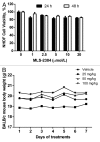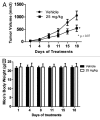MLS-2384, a new 6-bromoindirubin derivative with dual JAK/Src kinase inhibitory activity, suppresses growth of diverse cancer cells
- PMID: 24100507
- PMCID: PMC3928133
- DOI: 10.4161/cbt.26721
MLS-2384, a new 6-bromoindirubin derivative with dual JAK/Src kinase inhibitory activity, suppresses growth of diverse cancer cells
Abstract
Janus kinase (JAK) and Src kinase are the two major tyrosine kinase families upstream of signal transducer and activator of transcription (STAT). Among the seven STAT family proteins, STAT3 is constitutively activated in many diverse cancers. Upon activation, JAK and Src kinases phosphorylate STAT3, and thereby promote cell growth and survival. MLS-2384 is a novel 6-bromoindirubin derivative with a bromo-group at the 6-position on one indole ring and a hydrophilic group at the 3'-position on the other indole ring. In this study, we investigated the kinase inhibitory activity and anticancer activity of MLS-2384. Our data from in vitro kinase assays, cell viability analyses, western blotting analyses, and animal model studies, demonstrate that MLS-2384 is a dual JAK/Src kinase inhibitor, and suppresses growth of various human cancer cells, such as prostate, breast, skin, ovarian, lung, and liver. Consistent with the inactivation of JAK and Src kinases, phosphorylation of STAT3 was inhibited in a dose-dependent manner in the cancer cells treated with MLS-2384. STAT3 downstream proteins involved in cell proliferation and survival, such as c-Myc and Mcl-1, are downregulated by MLS-2384 in prostate cancer cells, whereas survivin is downregulated in A2058 cells. In these two cancer cell lines, PARP is cleaved, indicating that MLS-2384 induces apoptosis in human melanoma and prostate cancer cells. Importantly, MLS-2384 suppresses tumor growth with low toxicity in a mouse xenograft model of human melanoma. Taken together, MLS-2384 demonstrates dual JAK/Src inhibitory activity and suppresses tumor cell growth both in vitro and in vivo. Our findings support further development of MLS-2384 as a potential small-molecule therapeutic agent that targets JAK, Src, and STAT3 signaling in multiple human cancer cells.
Keywords: JAK; STAT3; Src; apoptosis; bromoindirubin; cancer cells; indirubin.
Figures





Similar articles
-
A novel 7-bromoindirubin with potent anticancer activity suppresses survival of human melanoma cells associated with inhibition of STAT3 and Akt signaling.Cancer Biol Ther. 2012 Nov;13(13):1255-61. doi: 10.4161/cbt.21781. Epub 2012 Aug 16. Cancer Biol Ther. 2012. PMID: 22895078 Free PMC article.
-
6-Bromoindirubin-3'-oxime inhibits JAK/STAT3 signaling and induces apoptosis of human melanoma cells.Cancer Res. 2011 Jun 1;71(11):3972-9. doi: 10.1158/0008-5472.CAN-10-3852. Epub 2011 May 24. Cancer Res. 2011. PMID: 21610112 Free PMC article.
-
Dual inhibition of Janus and Src family kinases by novel indirubin derivative blocks constitutively-activated Stat3 signaling associated with apoptosis of human pancreatic cancer cells.Mol Oncol. 2013 Jun;7(3):369-78. doi: 10.1016/j.molonc.2012.10.013. Epub 2012 Nov 16. Mol Oncol. 2013. PMID: 23206899 Free PMC article.
-
IL-3 signaling and the role of Src kinases, JAKs and STATs: a covert liaison unveiled.Oncogene. 2000 May 15;19(21):2532-47. doi: 10.1038/sj.onc.1203594. Oncogene. 2000. PMID: 10851052 Review.
-
Role of STAT3 in the initiation, progression, proliferation and metastasis of breast cancer and strategies to deliver JAK and STAT3 inhibitors.Life Sci. 2022 Nov 15;309:120996. doi: 10.1016/j.lfs.2022.120996. Epub 2022 Sep 25. Life Sci. 2022. PMID: 36170890 Review.
Cited by
-
Crucial Role of Reactive Oxygen Species (ROS) for the Proapoptotic Effects of Indirubin Derivatives in Cutaneous SCC Cells.Antioxidants (Basel). 2021 Sep 24;10(10):1514. doi: 10.3390/antiox10101514. Antioxidants (Basel). 2021. PMID: 34679649 Free PMC article.
-
Oximes: Novel Therapeutics with Anticancer and Anti-Inflammatory Potential.Biomolecules. 2021 May 22;11(6):777. doi: 10.3390/biom11060777. Biomolecules. 2021. PMID: 34067242 Free PMC article. Review.
-
Highlighted STAT3 as a potential drug target for cancer therapy.BMB Rep. 2019 Jul;52(7):415-423. doi: 10.5483/BMBRep.2019.52.7.152. BMB Rep. 2019. PMID: 31186087 Free PMC article. Review.
-
STAT3 signaling in ovarian cancer: a potential therapeutic target.J Cancer. 2020 Jan 1;11(4):837-848. doi: 10.7150/jca.35011. eCollection 2020. J Cancer. 2020. PMID: 31949487 Free PMC article. Review.
-
Structural basis of valmerins as dual inhibitors of GSK3β/CDK5.J Mol Model. 2014 Sep;20(9):2407. doi: 10.1007/s00894-014-2407-1. Epub 2014 Aug 21. J Mol Model. 2014. PMID: 25142337
References
Publication types
MeSH terms
Substances
Grants and funding
LinkOut - more resources
Full Text Sources
Other Literature Sources
Miscellaneous
